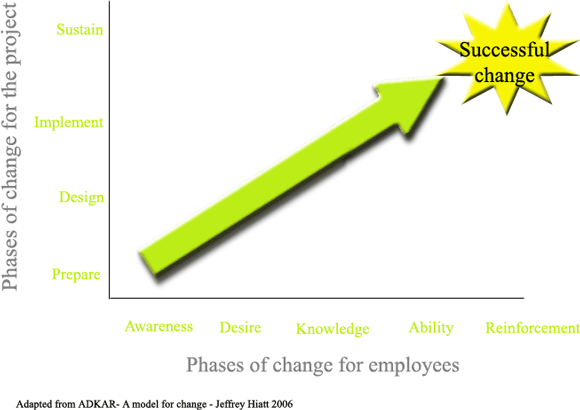ADKAR was developed by Jeff Hiatt of Prosci research in 1998 and was initially used as a tool for determining if change management activities were having the desired results during organisational change.
Now, it is used widely and for many, the tool of choice to help identify and drive change whilst also being used as a tool to understand any gaps that are needed to strengthen along the change process.
It is also a useful framework for planning change within an organisation, before implementation, and more importantly, a useful model In the Execute phase of the change management process.
The theory is simple: Each step in the ADKAR model focuses on people and how to create the right conditions for those effected by change to eventually adopt new behaviours and ways of working.
The Five Elements of ADKAR
Each element of the ADKAR change management model must be thoroughly completed and should also be followed in a sequential basis in order for successful change to take place. The five Steps of the ADKAR change management Model are as follows:
Awareness – Create an understanding for the need to change – I.E. Why is the change necessary? Why is it happening now? What is wrong with what we are doing today? What will happen if we don’t change? What’s in it for the individuals?
Desire – Create the desire to support and take part in the change – Which is dependent on the nature of change, the credibility of the person leading the message of change, intrinsic factors, history of the organisation. Effective leading and influencing can go a long way to help people choose to follow the desire to change.
Knowledge – Give knowledge so people can understand how to change and what to do – I.E. providing training and education, detailed understanding of new tasks, processes and systems, and understanding new roles and responsibilities.
Ability – Provide the skills to implement change on a day to day basis – I.E. Providing day to day involvement, access to subject matter experts, provide effect performance monitoring, hands on exercise during training.
Reinforcement – Create the ability and environment to sustaining the change and keep it going, keeping the momentum going. – I.E. Celebrations and recognition, rewards, feedback to and from employees, audits and performance measurement systems, accountability systems.
Factors Effecting Successful Change
In order to successfully apply change using the ADKAR change management model, it is advisable that one understand the barriers that could form at each stage. Once identified, plans can be created to remove these factors, and therefore effectively creating change.
Examples of those factors which can form barriers at each stage of the ADKAR change management program are:
Awareness – A person’s view of the current state, How a person perceives problems, Credibility and trust of the leader, misinformation and rumours that circulate, disagreement of the need to change.
Desire – The nature of change (incremental or large transformation), “What’s in it for me?” An individual’s personal life, intrinsic motivation – what motivates them?
Knowledge – The current knowledge base of an individual, the capacity and capability of the individual to gain additional knowledge, resources available for education, the access to expertise and this knowledge for learning.
Ability – Psychological blocks and fear, physical ability to work the new way, intellectual capability, the time available to develop the new skills, the availability of resources to develop those skills.
Reinforcement – How meaningful to the individual is this change? Is the progress demonstrated and reinforced? Is there a no blame culture? Are there accountability systems in place?
ADKAR Change Management for the Manager
As a manager, you can use this model to identify gaps in your change management process and to provide effective coaching for your employees.
The ADKAR model can also be used to:
- diagnose employee resistance to change
- used as a learning tool in teaching change
management - a framework for change management teams to evaluate
their change management plans - a coaching tool for managers and supervisors
- help employees transition through the change
process - create a successful action plan for personal and
professional advancement during change - develop a transition plan within change management,
for your employees - To track progress and understand gaps to any existing
change program
Linking Cultural change to the Change Management Process

As demonstrated using the Change management process, there are two tasks that successful change programs have to achieve:
- the change management process, which focuses on the
hard tangible side of change – the process steps in the change management project
plan. - the transition of people – the softer side (and
hardest part), providing successful change in individuals and changing their
behaviours to a new desired state.
The ADKAR change management Model can be used throughout the change management process to ensure that the transition plan is successful and that the cultural change is happening successfully therefore can be used to support the change project as a tool to cultural change.
Bringing the two dimensions together in a logical format means that the business should be able to successfully close out its project objectives and tasks, whilst ensuring that cultural change is happening and transitioning well along its path. As one can see in the model above, ADKAR can go hand in hand with the change management process. It can be used to help prepare people for change, create a transition plan and also be used to gauge current change performance, highlighting any gaps in and areas of improvement in real time, within the five phases of the model.
